Mapping and Tracking Forest Burnt Areas in the Indio Maiz Biological Reserve Using Sentinel-3 SLSTR and VIIRS-DNB Imagery
Abstract
1. Introduction
2. Study Area and Satellite Data
2.1. Study Area
2.2. Applied Satellite Imagery
2.2.1. MODIS Terra
2.2.2. Sentinel-2 and Sentinel-3 Optical Imagery
2.2.3. VIIRS Day Night Band
3. Wildfire Monitoring
3.1. Burnt Area Estimation
3.2. Validation with Active Fire Data
3.3. VIIRS-DNB Fire Spot Delineation
4. Results
4.1. Burnt Area Estimation and Forest Fire Tracking
4.2. VIIRS-DNB Active Fire Time Series
5. Discussion
5.1. Applicability of Sentinel-3-SLSTR for Wildfire Monitoring
5.2. Forest Types Affected by the Wildfire Event
6. Conclusions
Author Contributions
Acknowledgments
Conflicts of Interest
References
- Krstic, N.; Henderson, S. Use of MODIS data to assess atmospheric aerosol before, during, and after community evacuations related to wildfire smoke. Remote Sens. Environ. 2015, 116, 1–7. [Google Scholar] [CrossRef]
- Chen, G.; He, Y.A.; de Santis, A.; Li, G.S.; Cobb, R.; Meentemeyer, R.K. Assessing the impact of emerging forest disease on wildfire using Landsat and KOMPSAT-2 data. Remote Sens. Environ. 2017, 195, 218–229. [Google Scholar] [CrossRef]
- Fernandez-Garcia, V.; Santamarta, M.; Fernandez-Maso, A.; Quintano, C. Burn severity metrics in fire-prone pine ecosystems along a climatic gradient using Landsat imagery. Remote Sens. Environ. 2008, 206, 205–217. [Google Scholar] [CrossRef]
- Urbanski, S.; Salmon, J.; Nordgen, B.; Hao, W. A MODIS direct broadcast algorithm for mapping wildfire burned area in the western United States. Remote Sens. Environ. 2009, 113, 2511–2526. [Google Scholar] [CrossRef]
- Zavala, L.; de Celis, R.; Jordan, A. How wildfires affect soil properties: A brief review. Geogr. Res. Lett. 2014, 40, 311–342. [Google Scholar] [CrossRef]
- Conrado, M.; Chang, K.; Chen, C.; Chiang, S.; Santos, J. Modelling the spatial variability of wildfire susceptibility in Honduras using remote sensing and geographical information systems. Geomat. Nat. Hazards Risk 2016, 8, 402–417. [Google Scholar]
- Julio-Alvear, G. Managing efforts to prevent forest fires in South America. In Proceedings of the Second International Symposium on Fire Economics, Planning, and Policy: A Global View, Albany, CA, USA, April 2008. [Google Scholar]
- Villavicencio, F.; Salazar, M. Fuego Podría Extenderse al Límite de Reserva Indio Maíz. 2018. Available online: https://confidencial.com.ni/ (accessed on 11 April 2018).
- Torrez, C. Ambientalistas Sospechan de Mano Criminal en Incendio en la Reserva Indio Maíz. 2018. Available online: https://www.laprensa.com.ni/2018/04/05/nacionales/2399577-incendio-devora-reserva-indio-maiz/ (accessed on 5 April 2018).
- Romero, E.; Torrez, C. Fuego Arrasó con más de 5000 Hectáreas en la Reserva Indio Maíz. 2018. Available online: https://www.laprensa.com.ni/2018/04/13/nacionales/2403540-gobierno-asegura-que-se-termino-el-incendio-en-la-reserva-indio-maiz/ (accessed on 19 April 2018).
- Nicaragua Puts out Forest Fire in Southern Nature Reserve. 2018. Available online: https://apnews.com/ (accessed on 5 May 2018).
- Romero, E. Policía Presenta a Campesino Como Autor del Incendio de la Reserva Indio Maíz. 2018. Available online: https://www.laprensa.com.ni/2018/04/18/nacionales/2405640-policia-presenta-a-campesino-como-autor-del-incendio-de-la-reserva-indio-maiz/ (accessed on 19 April 2018).
- Waigl, C.; Stuefer, M.; Prakash, A.; Ichoku, C. Detecting high and low-intensity fires in Alaska using VIIRS I-band data: An improved operational approach for high latitudes. Remote Sens. Environ. 2017, 199, 389–400. [Google Scholar] [CrossRef]
- Potapov, P.; Hansen, M.C.; Stehman, S.V.; Loveland, T.R.; Pittman, K. Combining MODIS and Landsat imagery to estimate and map boreal forest cover loss. Remote Sens. Environ. 2008, 112, 3708–3719. [Google Scholar] [CrossRef]
- Röder, A.; Hill, J.; Duguy, B.; Alloza, J.; Vallejo, R. Using long time series of Landsat data to monitor fire events and post-fire dynamics and identify driving factors. A case study in the Ayora region (eastern Spain). Remote Sens. Environ. 2008, 112, 259–273. [Google Scholar] [CrossRef]
- White, J.; Ryan, K.; Key, C.; Running, S. Remote Sensing of Forest Fire Severity and Vegetation Recovery. Int. J. Wildland Fire 1996, 6, 125–136. [Google Scholar] [CrossRef]
- Pilar, M.; Ceccato, P.; Flasse, S.; Downey, I. Fire detection and fire growth monitoring using satellite data. In Remote Sensing of Large Wildfires; Springer: Berlin/Heidelberg, Germany, 1999; pp. 101–122. [Google Scholar]
- European Space Agency. Introducing Sentinel 3. Available online: https://www.esa.int/Our_Activities/Observing.../Sentinel-3/Introducing_Sentinel-3 (accessed on 3 May 2018).
- European Space Agency. Sentinel 3—Data Access and Products. 2015. Available online: https://sentinels.copernicus.eu/documents/247904/1848151/Sentinel-3_SLSTR_Data_Access_and_Products.pdf (accessed on 3 May 2018).
- European Space Agency. Sentinel 3 Coverage. 2018. Available online: https://sentinel.esa.int/web/sentinel/user-guides/sentinel-3-slstr/coverage (accessed on 1 May 2018).
- Ulloa, N.I.; Chiang, S.H. Mapping Forest Burned Areas in the Indio Maiz Biological Reserve Using SENTINEL-3 Slstr Imagery. In Proceedings of the American Geophysical Union Fall Meeting 2018, Washington, DC, USA, 10–14 December 2018. Abstracts NH23E-0875. [Google Scholar]
- Lee, T.; Miller, S.; Turk, J.; Schueler, C.; Julian, R.; Deyo, S.; Dills, P.; Wang, S. The NPOESS VIIRS Day/Night Visible Sensor. Bull. Am. Meteorol. Soc. 2006, 87, 191–200. [Google Scholar] [CrossRef]
- Hillger, D. First-Light Imagery from Suomi NPP VIIRS. Bull. Am. Meteorol. Soc. 2013, 94, 1019–1029. [Google Scholar] [CrossRef]
- Miller, S.; Straka, W., III; Mills, S.; Elvidge, C.; Lee, T.; Solbrig, J.; Walther, A.; Heidinger, A.; Weiss, S. Illuminating the Capabilities of the Suomi National Polar-Orbiting Partnership (NPP) Visible Infrared Imaging Radiometer Suite (VIIRS) Day/Night Band. Remote Sens. 2013, 5, 6717–6766. [Google Scholar] [CrossRef]
- Osher, S.; Sethian, J. Fronts propagating with curvature-dependent speed: Algorithms based on Hamilton-Jacobi formulations. J. Comput. Phys. 1988, 79, 12–49. [Google Scholar] [CrossRef]
- Malladi, R.; Sethian, J. Level set and fast marching methods in image processing and computer vision. In Proceedings of the 3rd the IEEE International Conference on Image Processing, Lausanne, Switzerland, 19 September 1996. [Google Scholar]
- Plan de Manejo Reserva Biologica Indio Maiz. Available online: http://www.bio-nica.info/Biblioteca/FUNDAR2004.pdf (accessed on 6 December 2019).
- Munera, C. Biocultural Design As a Framework to Identify Sustainability Issues in Rio San Juan Biosphere Reserve and Fortress of the Immaculate Conception, Nicaragua; UNESCO: Paris, France, 2014. [Google Scholar]
- Finley-Brook, M. Green Neoliberal Space: The Mesoamerican Biological Corridor. J. Lat. Am. Geogr. 2007, 6, 101–124. [Google Scholar] [CrossRef]
- Independent Evaluation Group. The Mesoamerican Biological Corridor: Regional Program Review; World Bank: Washington, DC, USA, 2011. [Google Scholar]
- Douglas, G. Mesoamerican Biological Corridor: Mexico to Panama. 2011. Available online: http://www.tbpa.net/docs/62_Meso_American_Biological_Corridor.pdf (accessed on 1 May 2018).
- Meyer, A.; Huete-Perez, J. Conservation: Nicaragua Canal could wreak environmental ruin. Nature 2014, 506, 287–289. [Google Scholar] [CrossRef]
- Morales, S.; Zolotoff, J.; Gutierrez, M.; Torrez, M. Nicaragua. In Important Bird Areas Americas—Priority Sites for Biodiversity Conservation; BirdLife Internationa: Quito, Ecuador, 2009; pp. 281–288. [Google Scholar]
- Condit, R. Extracting Environmental Benefits from a New Canal in Nicaragua: Lessons from Panama. PLoS Biol. 2015, 13, e1002208. [Google Scholar] [CrossRef]
- Serrano-Sandi, J.; Bonilla-Murillo, F.; Sasa, M. Distribution, surface and protected area of palm-swamps in Costa Rica and Nicaragua. Rev. Biol. Trop. 2013, 61, 25–33. [Google Scholar]
- Roger, J.; Vermote, E.; Ray, J. MODIS Surface Reflectance User’s Guide Collection 6. 2015. Available online: https://modis-land.gsfc.nasa.gov/pdf/MOD09_UserGuide_v1.4.pdf (accessed on 2 May 2018).
- Immitzer, M.; Vuolo, F.; Atzberger, C. First Experience with Sentinel-2 Data for Crop and Tree Species Classifications in Central Europe. Remote Sens. 2016, 8, 166. [Google Scholar] [CrossRef]
- Clark, M. Comparison of simulated hyperspectral HyspIRI and multispectral Landsat 8 and Sentinel-2 imagery for multi-seasonal, regional land-cover mapping. Remote Sens. Environ. 2017, 200, 311–325. [Google Scholar] [CrossRef]
- Li, J.; Roy, D. A Global Analysis of Sentinel-2A, Sentinel-2B and Landsat-8 Data Revisit Intervals and Implications for Terrestrial Monitoring. Remote Sens. 2017, 9, 902. [Google Scholar]
- European Space Agency. Sentinel 3. 2018. Available online: https://earth.esa.int/web/guest/missions/esa-eo-missions/sentinel-3 (accessed on 20 April 2018).
- European Space Agency. Sentinel-3 User Handbook. 2013. Available online: https://sentinels.copernicus.eu/documents/247904/685236/Sentinel-3_User_Handbook (accessed on 25 April 2018).
- Donlon, C.; Berruti, B.; Buongiorno, A.; Ferreira, M.; Fermenias, P.; Frerick, J.; Goryl, P.; Klein, U.; Laur, H.; Mavrocordatos, C.; et al. The Global Monitoring for Environment and Security (GMES) Sentinel-3 mission. Remote Sens. Environ. 2012, 120, 37–57. [Google Scholar] [CrossRef]
- Malenovský, Z.; Rott, H.; Cihlar, J.; Schaepman, M.; Garcia-Santo, G.; Fernandes, R.; Berger, M. Sentinels for science: Potential of Sentinel-1, -2, and -3 missions for scientific observations of ocean, cryosphere, and land. Remote Sens. Environ. 2012, 120, 91–101. [Google Scholar] [CrossRef]
- Wooster, M.; Xu, W.; Nightingale, T. Sentinel-3 SLSTR active fire detection and FRP product: Pre-launch algorithm development and performance evaluation using MODIS and ASTER datasets. Remote Sens. Environ. 2012, 120, 236–254. [Google Scholar] [CrossRef]
- Rouse, J.W., Jr.; Haas, R.H.; Schell, J.A.; Deering, D.W. Monitoring Vegetation Systems in the Great Plains with ERTS. In Proceedings of the Third Earth Resources Technology Satellite-1 Symposium, Washington, DC, USA, 10–14 December 1973. [Google Scholar]
- Chen, W.; Moriya, K.; Sakai, T.; Koyama, L.; Cao, C. Mapping a burned forest area from Landsat TM data by multiple methods. Geomat. Nat. Hazards Risk 2016, 7, 384–402. [Google Scholar] [CrossRef]
- Gao, B. NDWI—A normalized difference water index for remote sensing of vegetation liquid water from space. Remote Sens. Environ. 1996, 58, 257–266. [Google Scholar] [CrossRef]
- Liu, Y.; Dai, Q.; Liu, J.; Liu, S.; Yang, J. Study of Burn Scar Extraction Automatically Based on Level Set Method using Remote Sensing Data. PLoS ONE 2014, 9, e87480. [Google Scholar] [CrossRef]
- Miller, J.; Yool, S. Mapping forest post-fire canopy consumption in several overstory types using multi-temporal Landsat TM and ETM data. Remote Sens. Environ. 2002, 82, 481–496. [Google Scholar] [CrossRef]
- Phua, M.; Tsuyiki, S.; Lee, J.; Ghani, M. Simultaneous detection of burned areas of multiple fires in the tropics using multisensor remote-sensing data. Int. J. Remote Sens. 2012, 33, 4312–4333. [Google Scholar] [CrossRef]
- Trimble. eCognition Developer 9.0 Reference Book; Trimble: Munich, Germany, 2014. [Google Scholar]
- Machala, M.; Zejdova, L. Forest Mapping Through Object-based Image Analysis of Multispectral and LiDAR Aerial Data. Eur. J. Remote Sens. 2014, 47, 117–131. [Google Scholar] [CrossRef]
- Weih, R.; Riggan, N. Object-based classification vs. pixel based classification: Comparative importance of multi-resolution imagery. In The International Archives of the Photogrammetry, Remote Sensing and Spatial Information Sciences; Copernicus Publications: Ghent, Belgium, 2010. [Google Scholar]
- Giglio, L.; Descloitres, J.; Justice, C.; Kaufman, Y. An Enhanced Contextual Fire Detection Algorithm for MODIS. Remote Sens. Environ. 2003, 87, 273–282. [Google Scholar] [CrossRef]
- Schroeder, W.; Olivia, P.; Giglio, L.; Csiszar, I. The New VIIRS 375 m active fire detection data product: Algorithm description and initial assessment. Remote Sens. Environ. 2014, 143, 85–96. [Google Scholar] [CrossRef]
- Zhang, T.; Wooster, M.; Xu, W. Approaches for synergistically exploiting VIIRS I- and M-Band data in regional active fire detection and FRP assessment: A demonstration with respect to agricultural residue burning in Eastern China. Remote Sens. Environ. 2017, 198, 407–424. [Google Scholar] [CrossRef]
- Liao, L.; Weiss, S.; Mills, S.; Hauss, B. Suomi NPP VIIRS day-night band on-orbit performance. J. Geophys. Res. Atmos. 2013, 118, 12705–12718. [Google Scholar] [CrossRef]
- Gao, L.; Shi, W.; Miao, Z.; Lv, Z. Method Based on Edge Constraint and Fast Marching for Road Centerline Extraction from Very High-Resolution Remote Sensing Images. Remote Sens. 2018, 10, 900. [Google Scholar] [CrossRef]
- Garrido, S.; Malfaz, M.; Blanco, D. Application of the fast marching method for outdoor motion planning in robotics. Robot. Auton. Syst. 2013, 61, 106–114. [Google Scholar] [CrossRef]
- Chiang, C.H.; Chiang, P.J.; Fei, C.C.; Liu, J.S. A comparative study of implementing Fast Marching Method and A* SEARCH for mobile robot path planning in grid environment: Effect of map resolution. In Proceedings of the IEEE Workshop on Advanced Robotics and Its Social Impacts, Hsinchu, Taiwan, 9–11 December 2007. [Google Scholar]
- Jbabdi, S.; Bellec, P.; Toro, R.; Daunizeau, J.; Pelegrini-Issac, M.; Benali, H. Accurate anisotropic fast marching for diffusion-based geodesic tractography. J. Biomed. Imaging 2008, 2008, 2. [Google Scholar] [CrossRef]
- Sifakis, E.; Tziritas, G.; Osher, S.; Paragios, N. Fast Marching Techniques for Visual Grouping and Segmentation. In Geometric Level Set Methods in Imaging, Vision, and Graphics; Springer: New York, NY, USA, 2003; pp. 159–174. [Google Scholar]
- Incendio en Indio Maíz afectó 2 de las 8 Áreas Protegidas de la Reserva de Biosfera Río San Juan. El Nuevo Diario. 2018. Available online: https://www.elnuevodiario.com.ni (accessed on 20 April 2018).
- Verhegghen, A.; Eva, H.; Ceccherini, G.; Achard, F.; Gond, V.; Gourlet-Fleury, S.; Cerutti, P. The Potential of Sentinel Satellites for Burnt Area Mapping and Monitoring in the Congo Basin Forests. Remote Sens. 2016, 8, 986. [Google Scholar] [CrossRef]
- Urquhart, G. Long-term Persistence of Raphia taedigera Mart. Swamps in Nicaragua. Biotropica 1999, 31, 565–569. [Google Scholar] [CrossRef]
- Zha, Y.; Gao, J.; Ni, S.; Shen, N. Temporal filtering of successive MODIS data in monitoring a locust outbreak. Int. J. Remote Sens. 2005, 26, 5665–5674. [Google Scholar] [CrossRef]
- Ji, R.; Xie, B.; Li, D.; Li, Z.; Zhang, X. Use of MODIS data to monitor the oriental migratory locust plague. Agric. Ecosyst. Environ. 2004, 104, 615–620. [Google Scholar] [CrossRef]
- Yin, G.; Yuan, Z.; Sun, Y.; Wang, T.; Zeng, Z.; Piao, S. MODIS Based Estimation of Forest Aboveground Biomass in China. PLoS ONE 2015, 10, e0130143. [Google Scholar] [CrossRef] [PubMed]
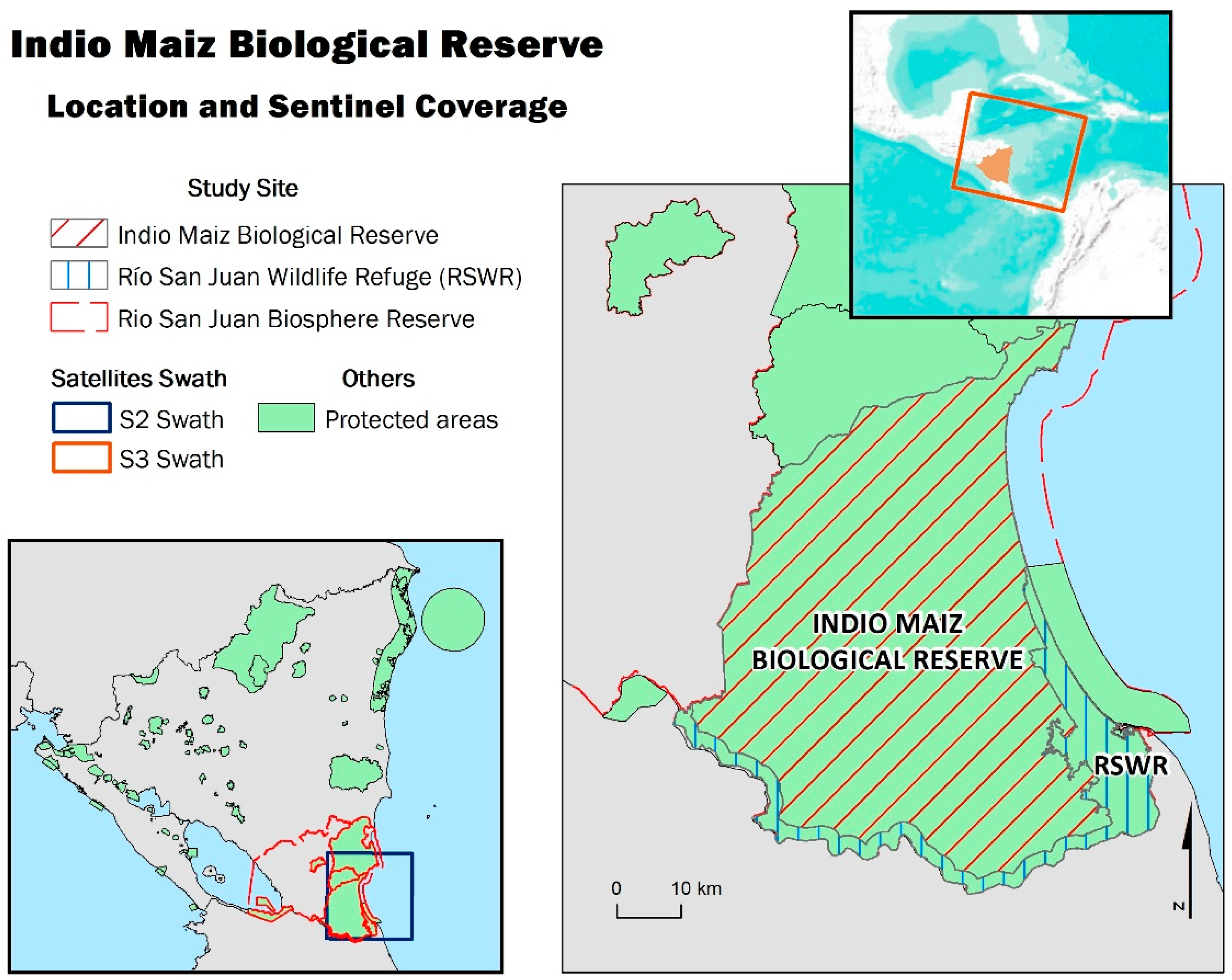
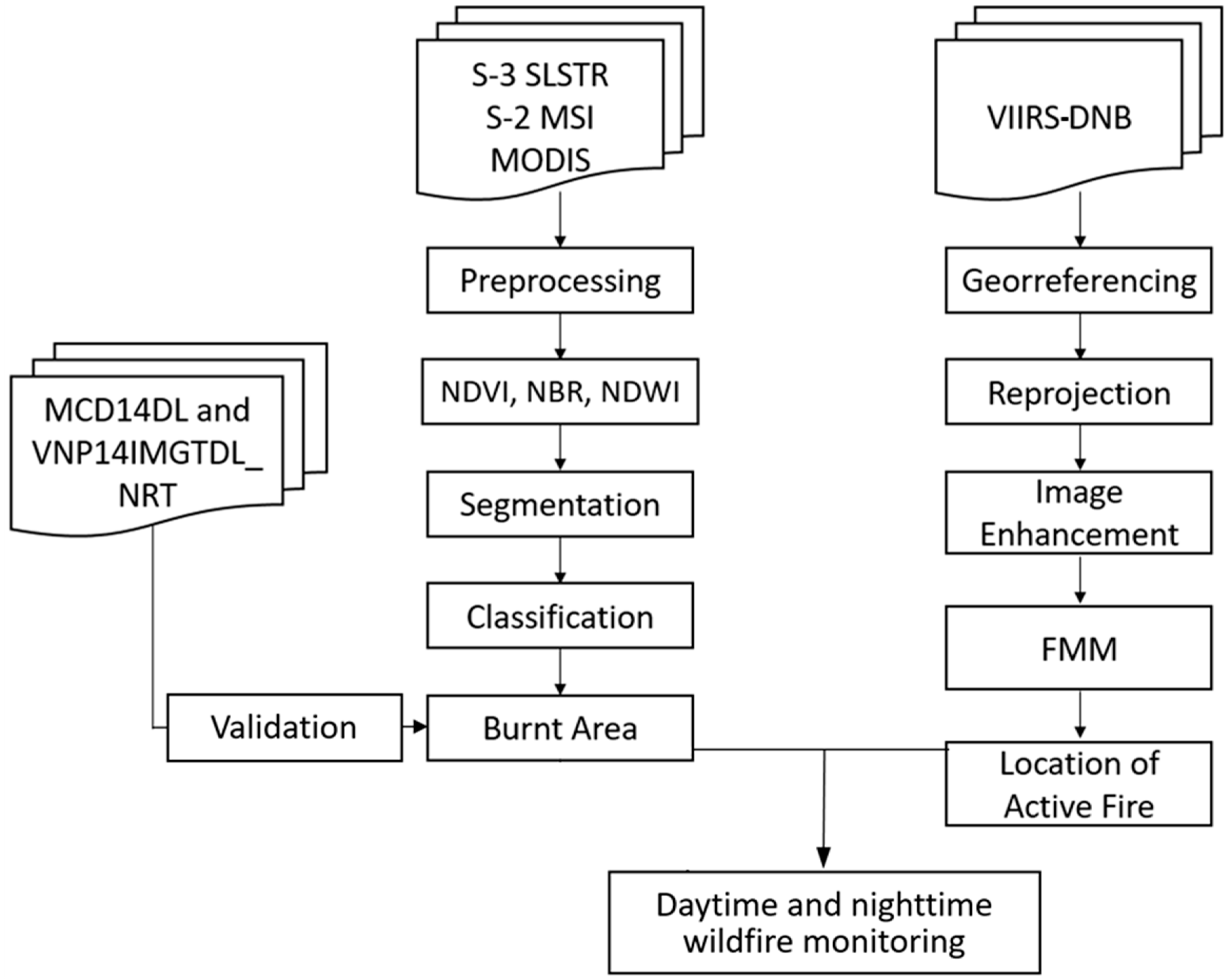
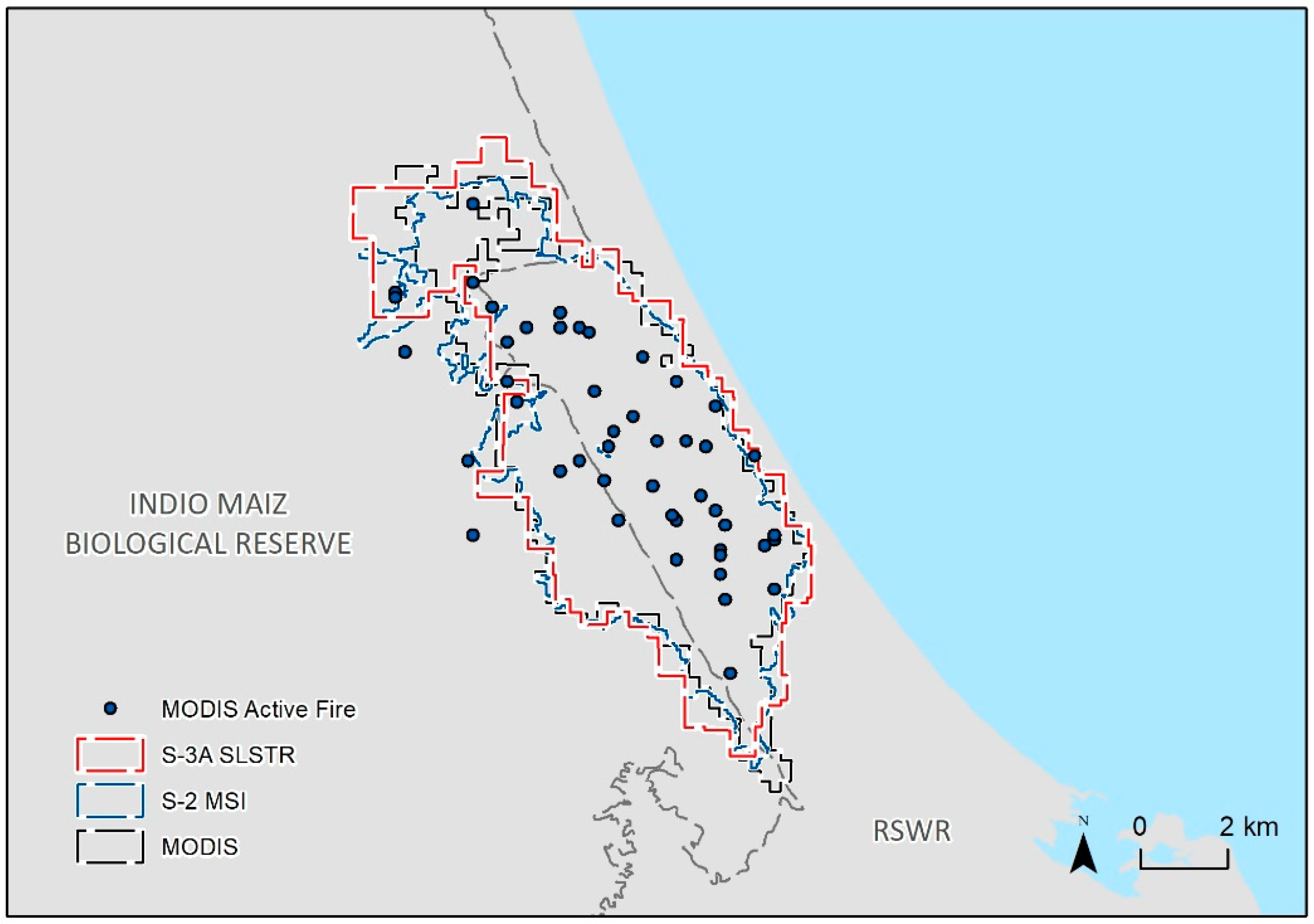

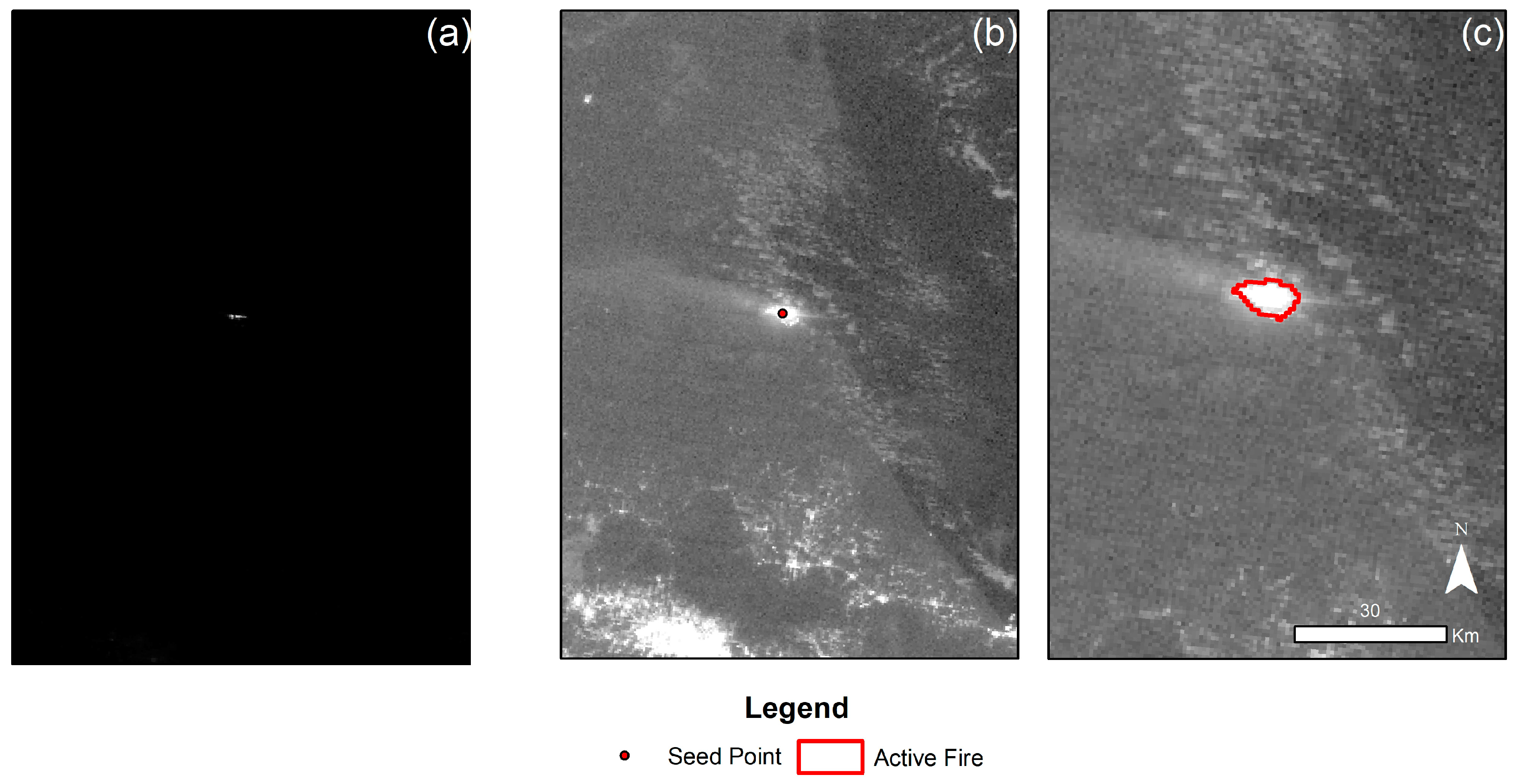
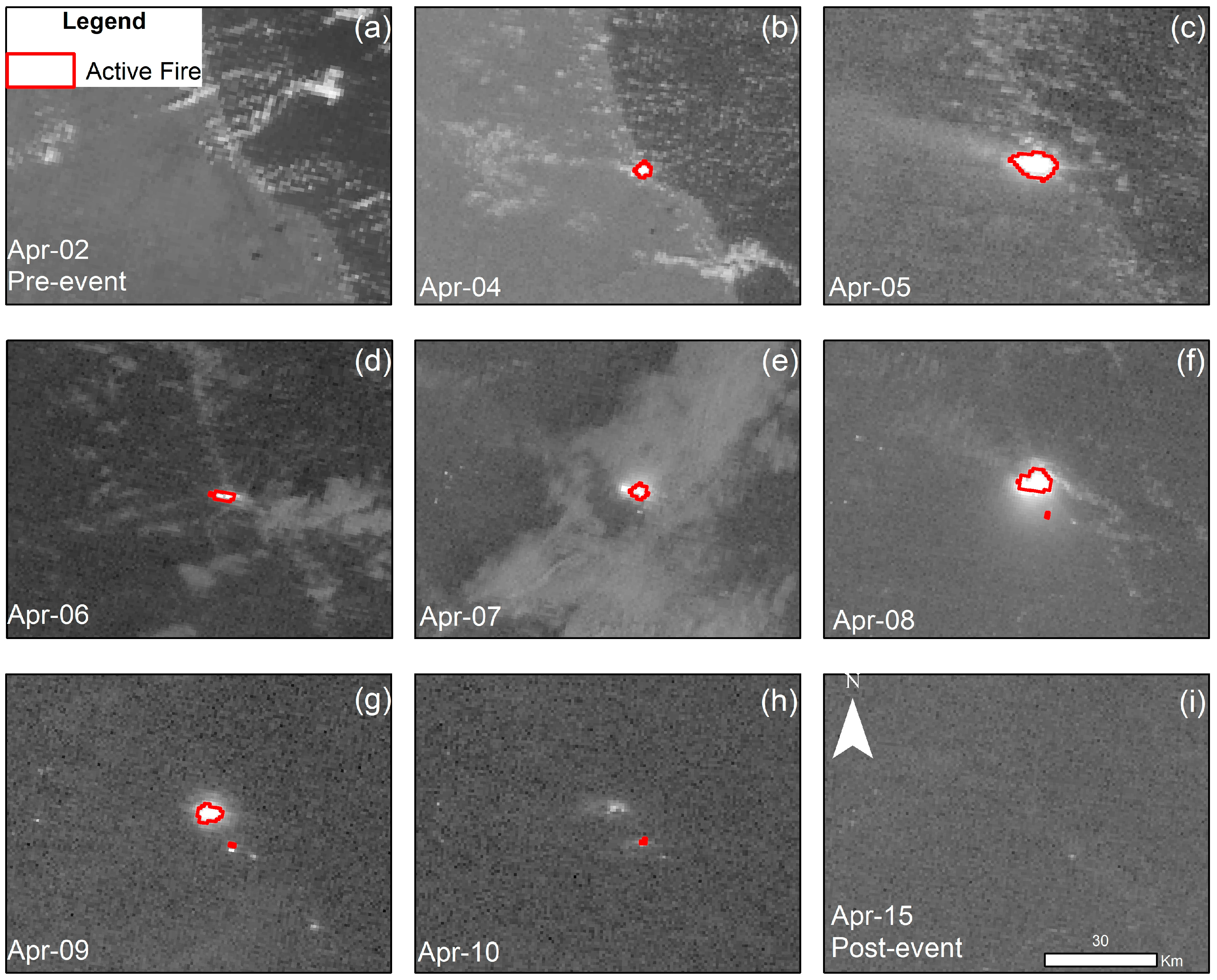


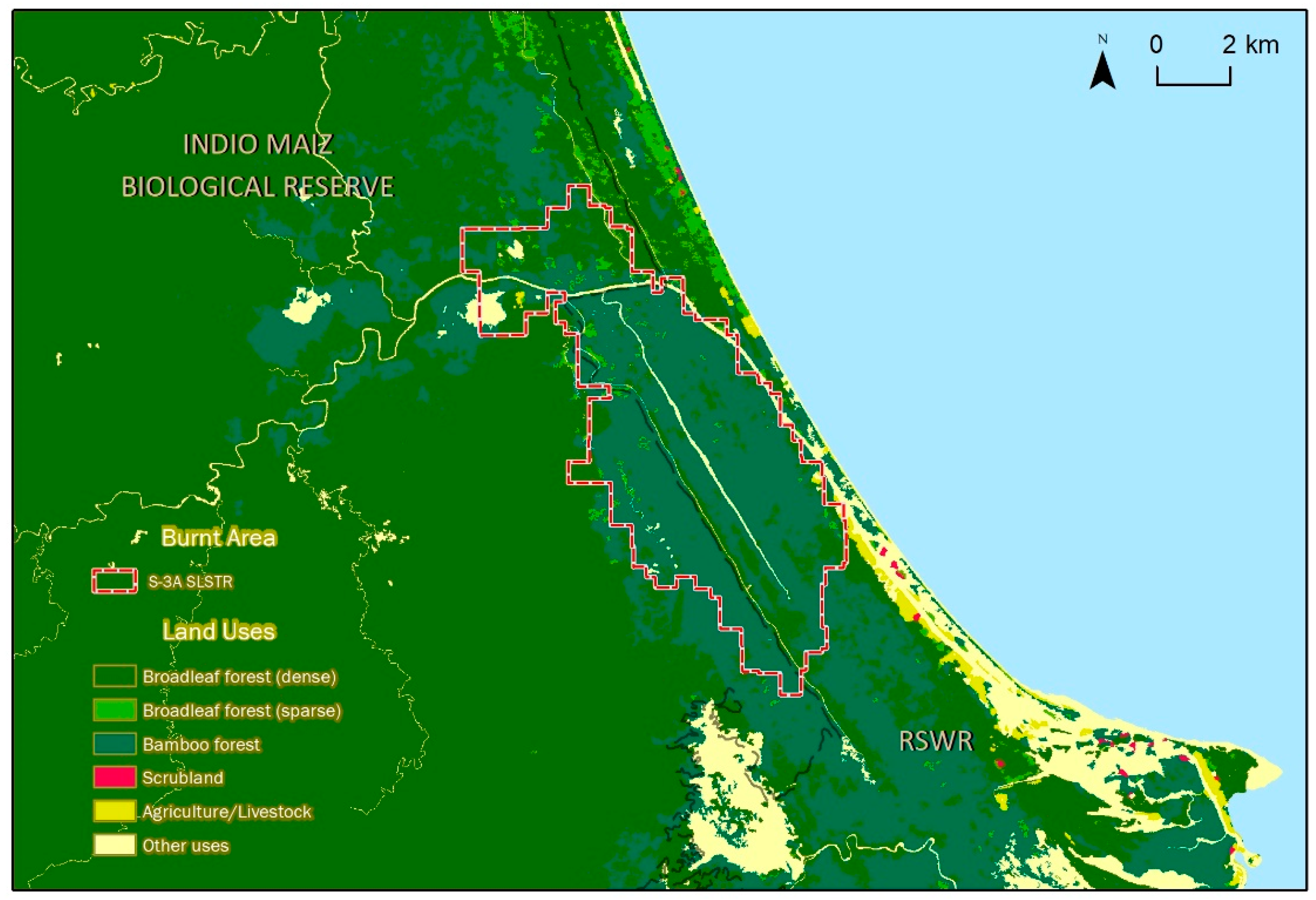
| Sensor/Date | 3 April | 4 April | 5 April | 6 April | 7 April | 8 April | 9 April | 10 April | 11 April | 12 April | 13 April |
|---|---|---|---|---|---|---|---|---|---|---|---|
| MODIS-Terra | abc | a | a | a | abc | a | abc | abc | abc | abc | abc |
| S2-MSI | na | na | na | a | na | na | na | na | a | na | na |
| S3-SLSTR | na | a | a | na | na | a | abc | na | abc | a | na |
| Index | Equation | Corresponding Bands | |
|---|---|---|---|
| S2-MSI | S3-SLSTR | ||
| NDVI | 8a (NIR); 4 (Red) | S3 (NIR); S2 (Red) | |
| NBR | 8a (NIR); 12 (SWIR 2) | S3 (NIR); S6 (SWIR 2) | |
| NDWI | 8a (NIR); 11(SWIR) | S3 (NIR); S5 (SWIR) | |
| Data | Scale | Shape | Compactness |
|---|---|---|---|
| MODIS-Terrra | 30 | 0.1 | 0.5 |
| S2-MSI | 5 | 0.1 | 0.5 |
| S3-SLSTR | 20 | 0.1 | 0.5 |
| Data | Accumulated Burnt Area (ha) | Spatial Resolution (m) |
|---|---|---|
| MODIS-Terrra | 5033.7 | 250 |
| S2-MSI | 5187.3 | 20 |
| S3-SLSTR | 5870.7 | 500 |
© 2019 by the authors. Licensee MDPI, Basel, Switzerland. This article is an open access article distributed under the terms and conditions of the Creative Commons Attribution (CC BY) license (http://creativecommons.org/licenses/by/4.0/).
Share and Cite
Chiang, S.-H.; Ulloa, N.I. Mapping and Tracking Forest Burnt Areas in the Indio Maiz Biological Reserve Using Sentinel-3 SLSTR and VIIRS-DNB Imagery. Sensors 2019, 19, 5423. https://doi.org/10.3390/s19245423
Chiang S-H, Ulloa NI. Mapping and Tracking Forest Burnt Areas in the Indio Maiz Biological Reserve Using Sentinel-3 SLSTR and VIIRS-DNB Imagery. Sensors. 2019; 19(24):5423. https://doi.org/10.3390/s19245423
Chicago/Turabian StyleChiang, Shou-Hao, and Noel Ivan Ulloa. 2019. "Mapping and Tracking Forest Burnt Areas in the Indio Maiz Biological Reserve Using Sentinel-3 SLSTR and VIIRS-DNB Imagery" Sensors 19, no. 24: 5423. https://doi.org/10.3390/s19245423
APA StyleChiang, S.-H., & Ulloa, N. I. (2019). Mapping and Tracking Forest Burnt Areas in the Indio Maiz Biological Reserve Using Sentinel-3 SLSTR and VIIRS-DNB Imagery. Sensors, 19(24), 5423. https://doi.org/10.3390/s19245423





